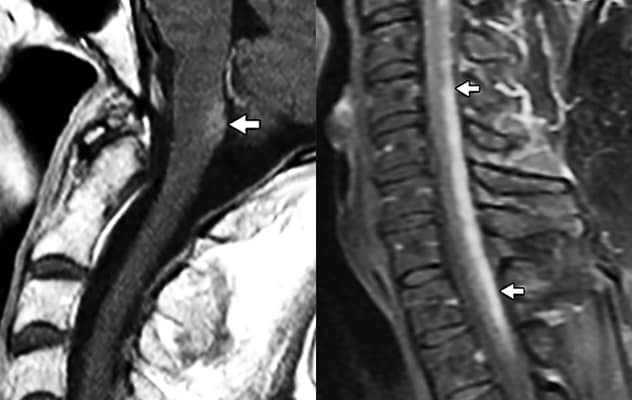Sept. 21, 2022
Mayo Clinic has led the work establishing neuromyelitis optica spectrum disease (NMOSD) as a distinct clinical entity. Timely diagnosis and treatment are key to preserving long-term neurological function for individuals with this autoimmune disease.
Lesions in the AQP4-enriched postrema

Lesions in the AQP4-enriched postrema
On the left, MRI shows lesions in the AQP4-enriched postrema, characteristic of some patients with NMOSD. On the right, MRI of a patient with sarcoidosis illustrates the differing imaging characteristics of the two conditions.
"NMOSD manifests primarily as relapsing episodes of severe optic neuritis and longitudinally extensive transverse myelitis," says Dean M. Wingerchuk, M.D., an autoimmune neurologist at Mayo Clinic in Phoenix/Scottsdale, Arizona. "An attack might leave the person with blindness in an eye or difficulty walking. The attacks are very unpredictable, and each one leads to additional disability for most patients."
In a review published in the Aug. 18, 2022, edition of The New England Journal of Medicine, Mayo Clinic neurologists outline the clinical features of NMOSD and Mayo Clinic's approach to diagnosis and treatment.
"Although NMOSD is considered rare, it accounts for one-third or more of cases of central nervous system inflammation among Asian and other nonwhite populations," says Claudia F. Lucchinetti, M.D., an autoimmune neurologist at Mayo Clinic in Rochester, Minnesota. "The primary, seropositive form of the disease has a female preponderance that approaches 90%."
The complexities of diagnosis and treatment
Once considered a variant of multiple sclerosis, NMOSD is characterized by more-severe attacks and less complete recovery. The disease spectrum covers the canonical clinical features of neuromyelitis optica as well as other characteristic syndromes and the finding of pathogenic AQP4-IgG autoantibodies.
"The AQP4-IgG antibody is detectable in more than 80% of individuals with NMOSD. It initiates the inflammatory central nervous system lesions and clinical manifestations of the disease," Dr. Lucchinetti says.
The AQP4-IgG autoantibodies were discovered by a team led by Vanda A. Lennon, M.D., Ph.D., an immunologist at Mayo Clinic's Rochester campus. Subsequent studies facilitated improved understanding of the immunopathological mechanisms underlying the disorder.
Diagnostic criteria for NMOSD require the manifestation of at least one of six core clinical syndromes. MRI is used to detect lesions characteristic of NMOSD in the brain, optic nerve, optic chiasm or spinal cord. A serum assay can establish the presence of AQP4-IgG autoantibodies.
"If AQP4-IgG testing is negative or not available, current criteria still allow for the diagnosis of NMOSD," Dr. Wingerchuk says. For diagnosis, those cases rely on stringent clinical and MRI criteria and the exclusion of other causes of the individual's symptoms.
Acute relapses of NMOSD have typically been treated with glucocorticoids and sometimes plasma exchange. Preventive medication is now an option. Three monoclonal antibody therapies — eculizumab, inebilizumab and satralizumab — have been approved for adults with NMOSD and AQP4-IgG autoantibodies.
"These medications target the steps in the immunopathogenesis of NMOSD," Dr. Lucchinetti says. Her pathological studies were the first to suggest that the complement system plays a key role in tissue damage in NMOSD, and the study results provided the rationale for the clinical trial and subsequent approval of eculizumab — the first of the three medications to be approved.
Several factors are involved in selecting a therapy for an individual patient, including the frequency and route of administration.
"They're all excellent therapies. They're also quite different from one another in some respects," Dr. Wingerchuk says. "Our neurologists have seen hundreds of people with NMOSD. That experience is very helpful in counseling patients about treatment."
Expertise is essential throughout the process of diagnosing and treating NMOSD. "There is a great deal of clinical overlap among NMOSD and other autoimmune conditions," Dr. Wingerchuk says. "One-third of patients with seropositive NMOSD have a coexisting autoimmune condition, such as thyroiditis or systemic lupus erythematosus. Optimal care for these individuals requires the subspecialized expertise of autoimmune neurologists who are familiar with NMOSD."
For more information
Wingerchuk DM, et al. Neuromyelitis optica spectrum disorder. The New England Journal of Medicine. 2022;387:631.
Refer a patient to Mayo Clinic.